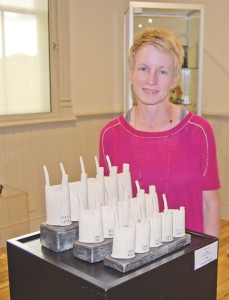Archive
Potters shine a light on the world around them through From Earth to Fire show
July 30, 2014 · 0 Comments

By Brock Weir
Artists sometimes lose sight of what they actually lose in the creative process, but potter Heather Smit is no ordinary artist.
A member of Aurora’s Pine Tree Potters Guild, she has always had a creative eye for material that can be found in the ground, but it wasn’t always clay. Her father, she says, was an industrial sewer, and she grew up around oil cans and industrial machines.
As her interest in art grew, she was attracted to the shape and form of oil cans and, really, “anything metal.” She studied metal at school, with a minor in clay, but eventually clay worked its way into the studio, and metal worked its way into her clay.

Her collection of ceramic oil cans with mysterious numbers etched into them attracted many a curious eye when “From Earth to Fire”, a new show hosted by the Pine Tree Potters Guild at the Aurora Cultural Centre opened earlier this month.
With many stopping to get a closer look, and an equal group questioning the two sets of numbers on each individual oil can, her work was recognized as “Most Imaginative” by noted ceramic artist Bruce Cochrane, who served as juror for the exhibition.
Oddly enough, however, the first person who might dispute the “imaginative” moniker is the artist herself.
“For me, the oil cans are something that I do in my regular work,” she says of From Earth to Fire. “The number on the top is the weight of the piece as raw clay. That is the earth. Then the number on the bottom is the weight of the completely finished, fired product. This is all about what you lose in the firing.
“To me, it is a pretty straightforward idea. I wanted to work with objects I am comfortable with. I don’t really see it as imaginative, but maybe. I think you often overlook what you lose in the process and, for me, my work is all about the process. I show the seams, I show the lines, and I show how the pieces are made.”
Ms. Smit’s theme of what one loses in the process was not represented solely with her oil cans. Many pieces gathered by the Guild members also had a wider message to get art aficionados thinking of the world around them. One piece created by Guild president Sara Stevens spoke to the protection of animals in a representation of an elephant breaking free of its chains.
Another showed anonymous faces obscured by a crimson representation of cloth, symbolising human rights abuses in the developing world.
While a further piece, an eye-catching work by Teresa Dunlop, shows former Senator Lieutenant-General Romeo Dallaire represented in a terracotta portrait vessel, a tradition of Peru’s Moche culture, a craft which flourished between the fifth and the ninth centuries.
“The vessels are really a remarkable collection of work,” says Ms. Dunlop. “They are all men and they were all ritual warriors in their society. They know now that for any one man there would be a series of vessels made throughout his life…and were probably given as tribute to neighbouring cultures in the Moche area.
“The reason I chose to have Romeo Dallaire is because of his role as a hero within our culture, as the vessels would depict heroes in their culture, and in particular for his work in Rwanda and in his work as a peacekeeper. Tied in with this piece, I have another piece in the show of a child soldier. One of his big pushes is to help reintegrate child soldiers into society, and that is why I thought it would be appropriate to bring the two pieces together for this exhibition.”











